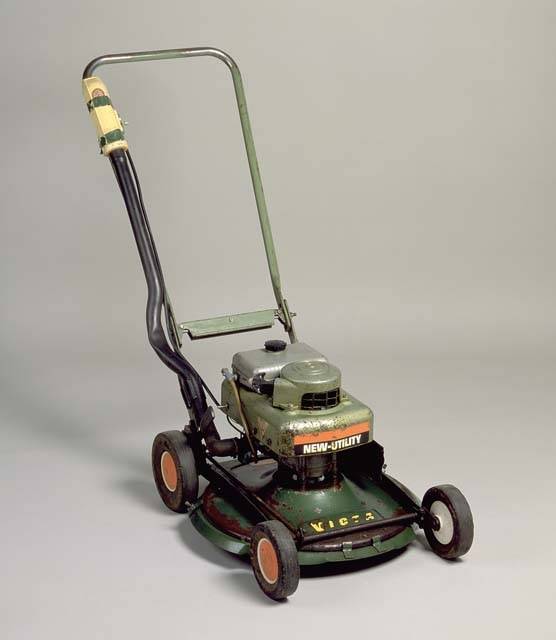October 27 - November 2, 2019: Issue 426
Collecting Lawnmowers: The Victa Mowers Story With A Careel Bay Link
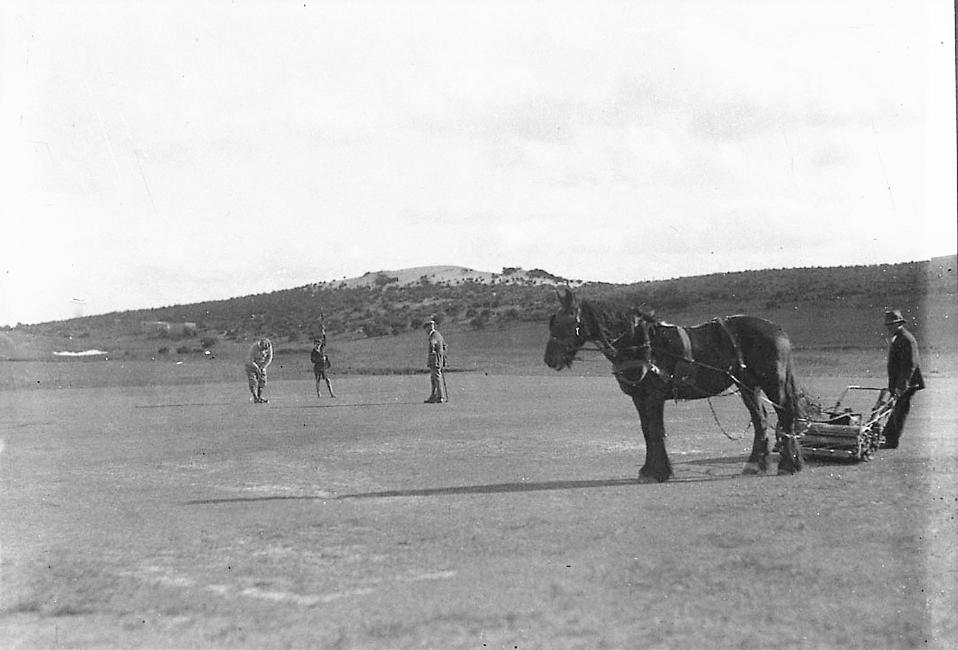
The sound of an Australian suburban Spring and Summer is the roar of the lawnmower of a Saturday or Sunday afternoon. The smell of newly cut grass epitomises the call to sip something cool 'neath shady trees or start up a game of backyard cricket.
Although collecting old lawnmowers and grass mowing machinery may appeal to boys more than girls, there are some reasons to celebrate Australian inventions during Spring. In McCormick-Deering Horse Drawn Mower we looked at one Australian invention for fields and mowing, while Reel Mowers looked into the beginnings of lawn mowers. Pittwater Online has even run a DIY page on How to Make Your Own Backyard Cricket Pitch, with push Reel Mowers and Rollers for pitches coming back in as saleable and collectors items that are actually in use a few years ago.There is a lawnmower used more frequently to keep the suburban lawn looking great - the Victa - with a local connection. Across the mouth of Careel Bay on the eastern side is a strange looking house built into the cliff. Designed by then Whale Beach resident and Architect Peter Muller, 'Kumale' was built in 1955 as a holiday home of Mervyn 'Victor' Richardson, inventor of the Victa lawn mower.
Back in the 1950s its semicircular concrete boatshed housed a small float plane. Peter Muller would also design the head office for Victa Industries.
Mr. Richardson developed the Victa lawnmower to help his son who mowed lawns in his university holidays.
The Careel Bay Richardson weekender, 'Kumale' - photo by Robyn McWilliam, 2012
Mervyn Richardson had a lifelong passion for motors and machines in cars as much as planes. He helped his elder brother Archibald to build a low-winged monoplane, for which they designed a radial engine with contra-rotating propellers, in 1912.
NEW MONOPLANE ENGINE.
RICHMOND, Sunday. — Richardson Bros., of Burwood, have brought to the Richmond aerodrome a monoplane, fitted with a very Interesting type of engine, from which wonderful things are expected by Its Inventors. The complete machine has been constructed by Richardson Brothers. It is the intention of the owners to attempt a flight in their machine at an early date. NEW MONOPLANE ENGINE. (1918, June 24). The Daily Telegraph (Sydney, NSW : 1883 - 1930), p. 7. Retrieved from http://nla.gov.au/nla.news-article239265043
The brothers were filmed demonstrating the machine at Mascot, Sydney. Later that day Archibald, who had invested everything in the project, crashed the aircraft beyond repair. However some archivists state this design was used by an Italian team to win the 1933 Schneider Trophy, one of Europe's most prestigious air races.
Mervyn Victor Richardson (1893-1972), inventor, was born on 11 November 1893 at Yarramalong, New South Wales, second son of Archibald George Herron Richardson, a schoolteacher from Dunganon, Ireland, and his native-born wife Charlotte Martha, née Griffith. Archibald taught in country schools (1889-99) and in Sydney (from 1912), and served as a Corporal in the Australian Remount Unit 2, Squadron 6 when aged 50. Formed in Sydney in September 1915, he departed Sydney via HMAT Orsova on November 10th 1915.
His family's address on his departure was 'Marton', Roscoe Street, Bondi.
The legendary reputation of Australian horses in the Sinai and Palestine campaigns was in no small part due to the work of the remount units, which were responsible for their training. When the Light Horse left for Gallipoli in 1915, they left behind detachments to take care of the horses. To free these men to rejoin their regiments, two remount units were formed in September 1915, each of four squadrons. The maximum age for enlistment was set at 50, and the units contained a high proportion of Boer War veterans and expert horsemen. By the time they arrived in Egypt however, the evacuation of Gallipoli was imminent. Accordingly, at the end of March 1916 the units were reduced by half, each contributing two squadrons to a single remount unit. Later in the year, the unit was further reduced to two squadrons, and became the Remount Depot. Although based in Egypt, in late 1917 the depot delivered remounts to the Palestine front by driving them across the Sinai in order to save scarce rail transport, and so is credited with participation in the Palestine campaign.
Archibald George Herron Richardson, after suffering from malaria, varicose veins and 'gout' was returned to Australia, per Hospital Ship (HS) Karoola, as a Lance Sergeant, landing August 5th, 1916.
In the 1920s Mervyn worked as a motorcar salesman. In 1927 he designed the Austin 'Wasp', a sporty, duck-tailed, coupé body for the locally assembled Austin 7 car.
S.B. & M.C. 24-HOUR TRIAL
The Sydney Bicycle and Motor Club 24-hour trial will start at 3.30 p.m. to-day from the Club Rooms, in Carrington Street.
The route will include Oberon, Young, Goulburn, and Bulli Pass, the total distance being 552 miles. The following entries have been received: —
Under Under 2000 c.c.: T. Rodda (Austin), T. Sulman (Austin Wasp), M. Richardson (Austin Wasp), W. G. Buckle (Triumph), H. Allen (Triumph), Ron Edwards (Triumph). H. Cordin (Morris Minor), R. Mobbs (Morris Cowley),. R. Victor (Morris Cowley).
Over 2000 c.c.: G. W. Dickinson (Vauxhall), W. Graham (Reo), B. N. Missen (Ford), A. E. Poole (Erskine), G. B. Watkins (Essex), R. L. Harper (Willys Knight), G. A. Gordon (Studebaker 8). Stops will be made at Hampton for tea, Young for supper, and Goulburn for breakfast. S.B. & M.C. 24-HOUR TRIAL (1929, June 29). The Daily Telegraph (Sydney, NSW : 1883 - 1930), p. 29. Retrieved from http://nla.gov.au/nla.news-article245638331
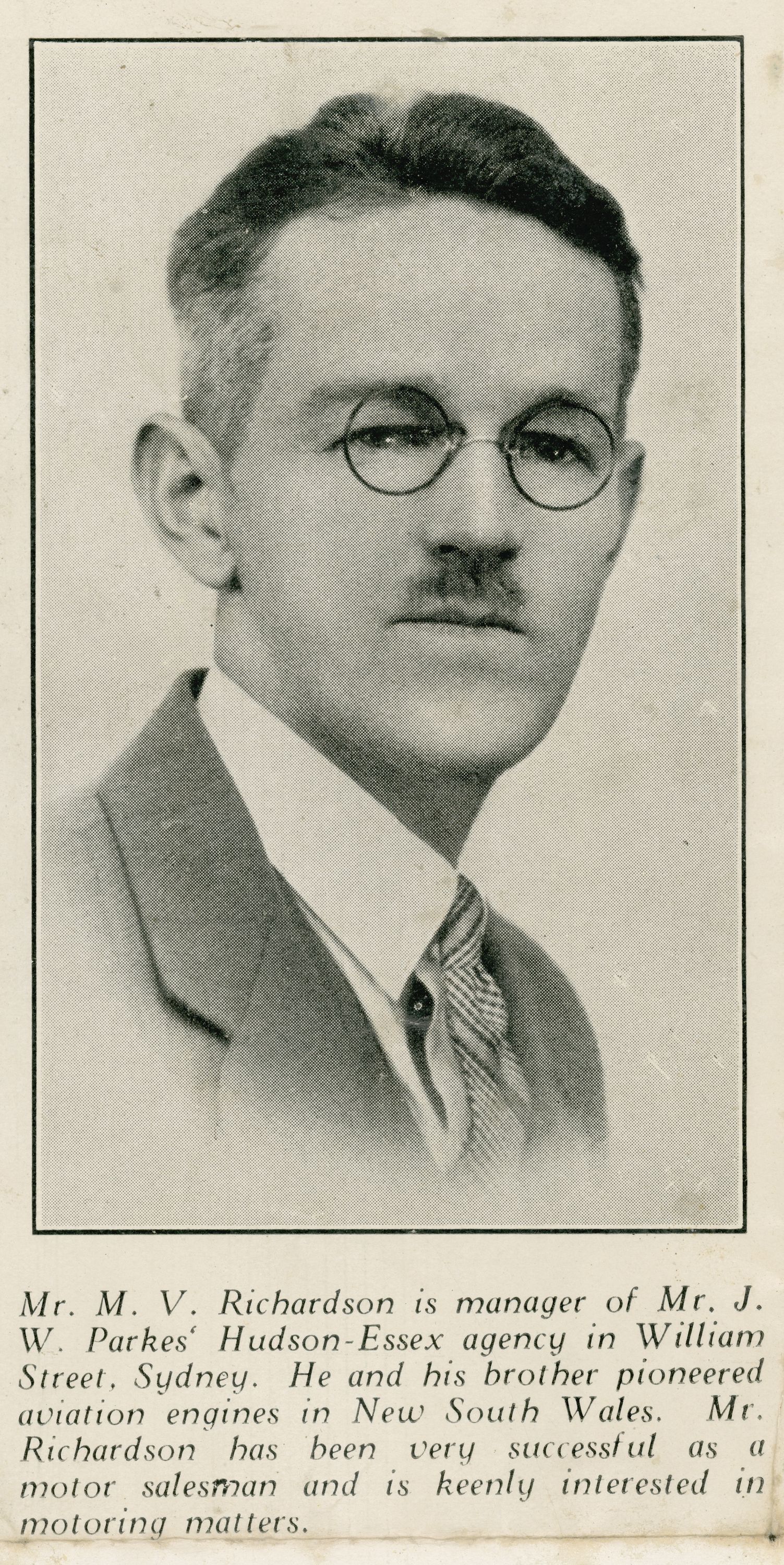
The October 1927 edition of the journal 'The Australian Motor Owner' (p.44), shows a black and white photograph of M.V. Richardson.
He set up New South Wales Motors Ltd and opened a showroom in William Street. In this little episode he and wife Vera Marie Bertram, a clerk, whom he married in June 1926, are taking one of those motors for a ride:
WAS HE JOY-RIDING?
MOTORIST WITH TRADER'S PLATE POLICE PROSECUTION FAILS
AN interesting case, under the Motor Traffic Act was heard at Windsor Police Court, before Mr J. B. Gibson, S.M., last week, when Mervyn Richardson, a young motor trader, was proceeded against for driving a vehicle with a trader's plate attached to it, such vehicle not then proceeding to or returning from a prospective purchaser for or after trial. Sergeant Loomes conducted the prosecution, and defendant, who pleaded not guilty, paddled his own canoe, as it were.
Constable Flint, of Windsor, stated that at about 4 p.m. on May 6, he saw the defendant, accompanied by his wife, driving a sports model Austin car along the Cattai-road, about two miles from Windsor. He signalled the defendant to stop, and, when he had done so the constable, said to him, "What are you doing with a trader's plate on this car?'' Defendant replied, "I'm 'running her in'." Witness said, "Has it been sold or on a trial run, or what is your reason for having it on the road?" Defendant said, "No, we are not allowed to sell these cars until they have done between 500 and 700 miles; and some police have told me that my trader's plate entitles me to do that running. We are not joy-riding—this is my wife with me — and if I were going for a joy-ride I would not drive this car. I have been driving it day and night, but have only done about 300 miles so far." The constable said, "'You have had sufficient running to know that all the parts are in order, and the machine in running condition." Defendant replied, "That is so; but when people buy one of these jobs, unless it has been 'run in' previously, they take it out and 'rev.' it up, and then bring it back after it has done about 500 miles and say, it is defective." Witness asked, "Why don't you register the car?" Defendant replied, "No; if I do that, buyers would regard it as a second-hand job; but at the same time, it is not for the purpose of avoiding motor tax or fees." The constable said, "I'll have to report this matter," whereupon defendant replied, "I may be wrong, but it is just as I have been told. I think I can sell this, one during the week."
In answer to Sergeant Loomes, witness said it was not necessary to drive a car 300 or 500 miles before it is "run in." Any car should be thoroughly "run in" after the first 100 miles. Questioned by the defendant, the constable admitted that he had had no experience in driving or handling an Austin sports model car, or any very small car, in fact. A Morris Cowley was the smallest car he had handled. Witness denied that defendant said to him on the day in question, "If I wanted to go for a joy-ride I would have not used this car. We have several used cars for that purpose."
Mervyn Victor Richardson, motor trader, of Wilberforce-avenue, Rose Bay, stated that he had been in business with a partner for about three months, and they carried on under the name of "New South Wales Motors." They had the agency for the Austin sports car. The car he was driving when the constable spoke to him was a sports model. He had to give several demonstrations on the following day, and unless the car had been "run in" thoroughly a satisfactory trial could not be given. The Austins were baby cars, and during the first 500 or 700 miles had to be driven by an expert driver. A demonstration given by a Car that had not been "run in" would very much prejudice a sale. Defendant added that he had seen several traffic policemen and not one of them questioned him as to the legality of using a trader's plate for "running in" a car. "You are quite within the law, in my opinion," they told him.
Sergeant Loomes: To whom was the plate issued?— To the New South Wales Motors, comprising a man named Stewart and myself.
What experience have you had in the motor business? — I have been a motor salesman for years.
Can you produce anything in writing — anything in the book of instructions given with an Austin car to show that it has to be "run-in" for 700 miles before it is sold? — No; I did not bring a book with me; I did not think it was necessary.
You know it is necessary to keep a register in which must be entered the name of the person who uses a trader's plate and the car on which it is used ?— Yes.
Can you produce that book? — I have got a book but did not bring it with me.
Sergeant Loomes contended that the defendant was not driving the car for the purpose of testing, but had been out joy-riding with his wife. "That is not so," replied Richardson; "I made several adjustments to the car along the road that day."
Sergeant Loomes: Are you aware of the fact that some light 'cars never got "run -in" at all?
Defendant: They're the kind that are sometimes "run in'' in a sort of way by their owners. It is absolutely necessary that Austin sports cars must be "run- in" by expert drivers. Those who hold opinions to the contrary have had no experience with Austin cars.
The S.M.: I can't see that any offence has been committed?
Sergeant Loomes: We say the car was not used for "running in" purposes. If people are permitted to drive unlimited distances in this way, the Department would lose heavily in taxes to which they are entitled.
The S.M., in dismissing the case, drew attention to the provisions of the Act which permitted cars to be tested whilst bearing a trader's plate. WAS HE JOY-RIDING? (1928, June 8). Windsor and Richmond Gazette (NSW : 1888 - 1954), p. 5. Retrieved from http://nla.gov.au/nla.news-article85925774
THE AUSTIN WASP ROADSTER
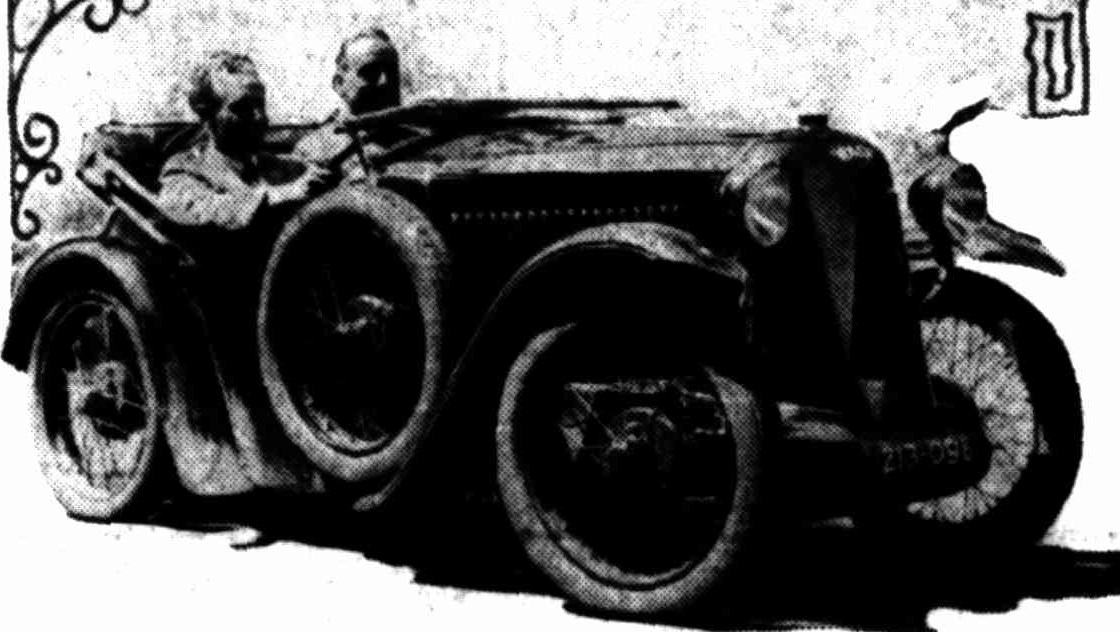
Carrying two passengers, whose combined weight exceeded 24 stone, and driving against headwinds and beating rain, this attractive little car gave a food impression of its capabilities throughout the run over 'Truth's' test course. THE AUSTIN WASP ROADSTER (1930, January 5). Truth (Sydney, NSW : 1894 - 1954), p. 22. Retrieved from http://nla.gov.au/nla.news-article169388253
This venture gave him success and financial security, but the business could not survive the Depression. By the early 1930s Mervyn, Vera and their baby son Garry were reduced to living in a single room at North Strathfield. Mervyn regularly walked to the city in search of work and eventually became a travelling salesman for the Gold Star Coupon Co. To supplement his income, he studied logarithmic scales so that he could calibrate (by hand) and sell slide-rules.
A new job as an engineering salesman led to improved circumstances. In 1941 the family moved to a house in Bray Street, Concord, that Mervyn Richardson had designed.
In 1948 Mr. Richardson had watched a public demonstration of the 'Mowhall' rotary-blade lawnmower, which required two people to push and pull it over long grass and was never a commercial success.
When son Garry started a lawn-mowing business during university vacations in 1951 his father made two complex reel-type mowers to help him. In August 1952 he decided to make a rotary lawn mower similar to the Mowhall, using a Villiers two-stroke engine mounted on its side but utilising a lighter base plate, allowing use by a single operator. He wanted it to be cheaper, lighter and more powerful. It was called the "Peach-Tin Prototype", so named because it was made out of scrap metal with a peach tin used as a fuel tank, scrap metal, billy-cart wheels, and a jam tin used as a petrol tank.
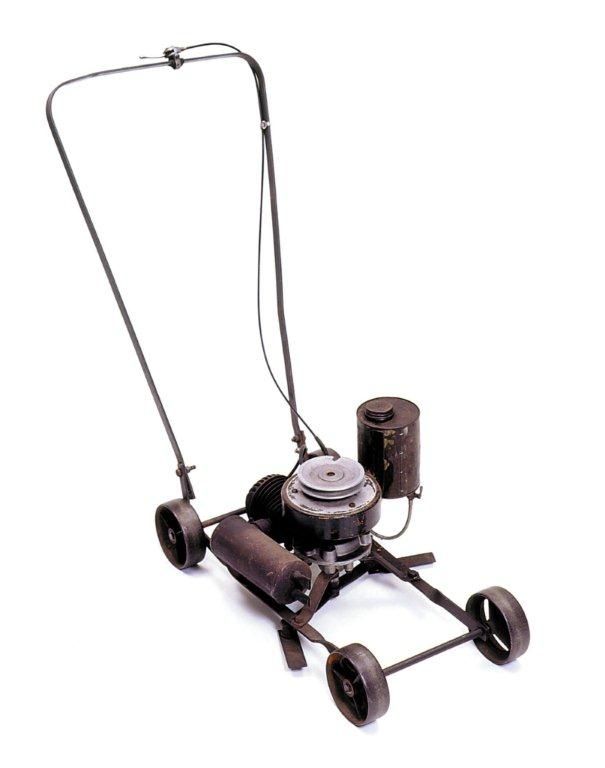
To his family's amazement the contraption cut fine grass with precision and yet could plough through long grass and weeds. Within three months thirty mowers had been sold - people wanted this easier way to keep their suburban lawn in good trim. Over the next two years he built and sold sixty reel-type mowers, powered by imported Villiers two-stroke engines.
VICTA Lightweight 18in Rotomo, 1-h.p. pet. engine, cuts to fences and any height of grass weeds; safe for 10-year-olds. £39/16/, plus tax. UF3093. Open All Saturday. Family Notices (1952, November 22). The Sydney Morning Herald (NSW : 1842 - 1954), p. 26. Retrieved from http://nla.gov.au/nla.news-article18291802
Mervyn continued to build lawnmowers in his backyard workshop and registered the name Victa Mowers (a corruption of his middle name) in the early 195o's. On Friday February 13th, 1953 Richardson gave up his job and became full-time manager of Victa Mowers Pty Ltd.
VICTA 18" ROTARY, PETROL Motor Mowers
Limited number only for IMMEDIATE DELIVERY
Demand has almost caught up again with delivery of the outstanding VICTA Mower.
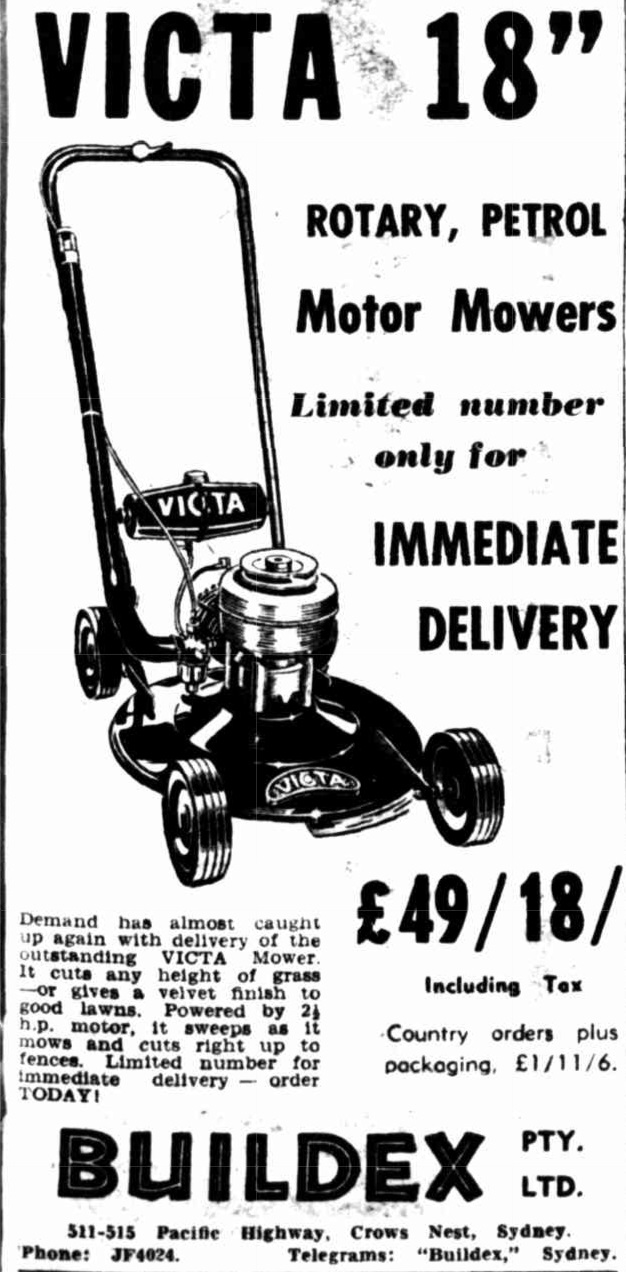
it cuts any height of grass —or gives a velvet finish to good lawns. Powered by 2½ h.p. motor, It sweeps as it mows and cuts right up to fences. Limited number for Immediate delivery — order TODAY ! BUILDEX PTY. LTD. 511-515 Pacific Highway, Crows Nest, Sydney. Phone: JF4024. Telegrams: 'Buildex,' Sydney. Advertising (1955, September 30). The Farmer and Settler (Sydney, NSW : 1906 - 1955), p. 43. Retrieved from http://nla.gov.au/nla.news-article123146153
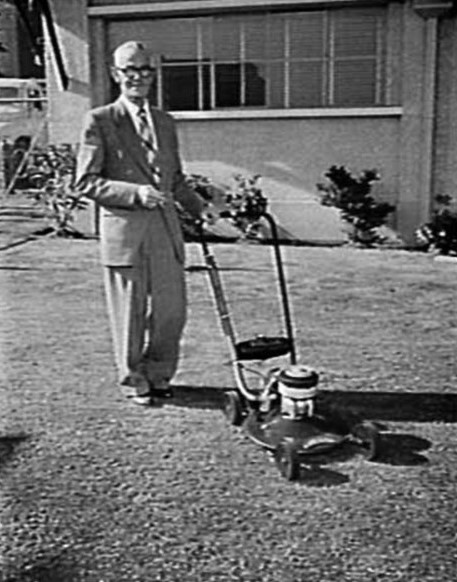
Victa rotary lawnmower and Mervyn Victor Richardson, the owner of the company - 1955 - photo by Jack Hickson, Australian Photographic Agency - 01148. Taken by Australian Photographic Agency for account: Graves, Hayes & Baker 1642/55.
NOW is the time to order your VICTA 18' ROTOMO the NEW 2½ h.p. Victa 125 c.c. PETROL Motor LAWN MOWER
Limited number for immediate delivery.
More than double the power of earlier models.
3 times faster cutting.
18-inch wide cut . . . RIGHT UP TO fences and walls.
Safe . . . even in rain—no leads to cut or short.
Adjustable cutting height from "shaving" to 2¼ inches.
Velvet smooth finish on good lawns.
Eliminates hand clipping.
Cuts backwards as well as forwards.
£45.5.3
Plus Tax, £4/13/9
On Easy Terms.
CANBERRA AGENT Scott's for Hardware
KINGSTON and YARRALUMLA.
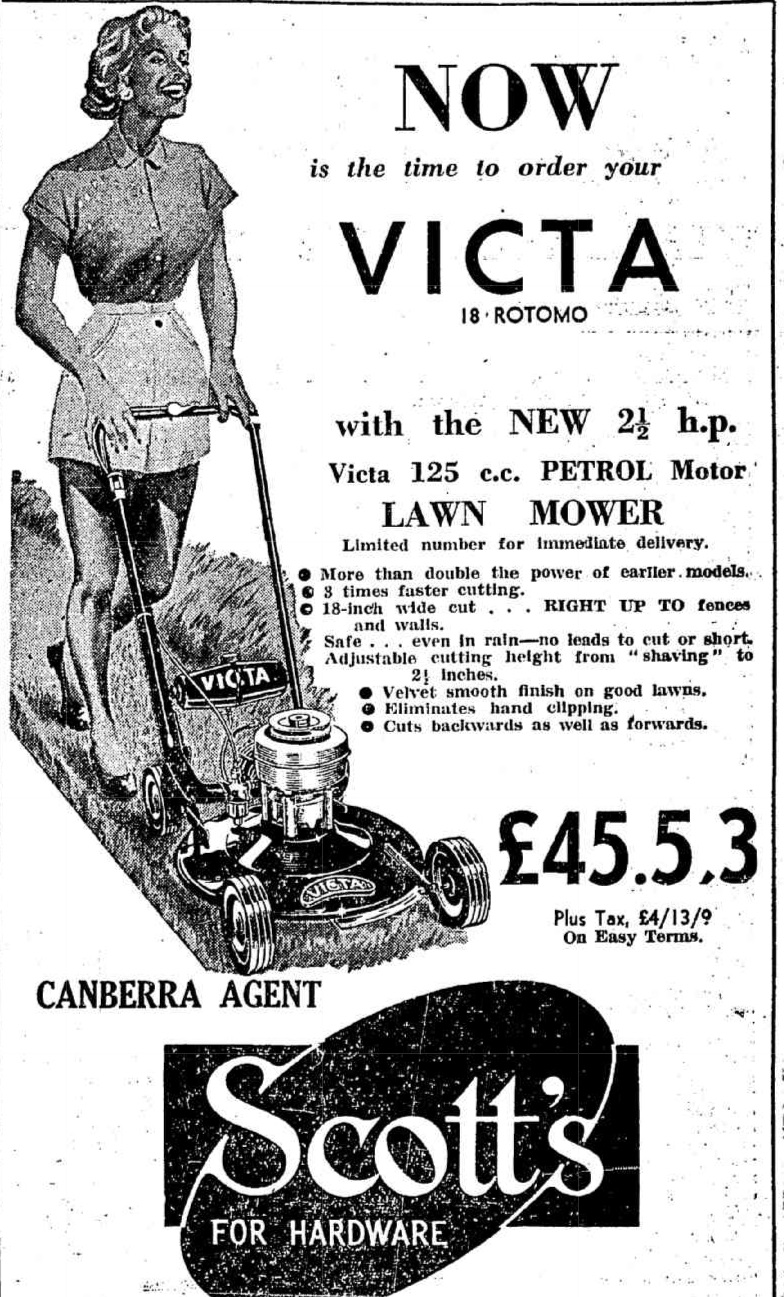
Advertising (1956, January 5). The Canberra Times (ACT : 1926 - 1995), p. 4. Retrieved from http://nla.gov.au/nla.news-article138116323
VICTA MOTOR MOWERS.
Petfoods, of Harris Street, Fairfield, have been appointed sole district agent for the well-known Victa motor mowers, and have them available for immediate delivery. Petfoods will make a special announcement in next issue. GRANVILLE BOWLING CLUB (1956, August 15). The Biz (Fairfield, NSW : 1928 - 1972), p. 10. Retrieved from http://nla.gov.au/nla.news-article189245842
VICTA MOWERS POPULAR
Perhaps the most popular petrol mower, ever marketed in Australia is the Victa motor mower, and it has achieved re cord sales through its performances and low price. Last week's large advt. in "Biz" by the Fairfield distributor Petfoods brought this solid mower before the public very forcibly and excellent sales resulted. If you desire a home demonstration, just phone, Mr. Lionel Pitt, of Petfoods, or call at Petfoods, Harris street, Fairfield. VICTA MOWERS POPULAR (1956, October 31). The Biz (Fairfield, NSW : 1928 - 1972), p. 14. Retrieved from http://nla.gov.au/nla.news-article189250880
By 1958 the company had moved to a new factory at Milperra and its 3000 employees were building 143,000 mowers a year for export to 28 countries.
In the 1960s Victa diversified: in addition to lawnmowers, the firm manufactured the 'red phone' (a private payphone system installed in shops and clubs), the Victa Airtourer (a light aircraft) and, for a short time, Victa project homes.
Always keen on hard work, he completed a draughtsman's course by correspondence while in his 50's, completing the three years work by in six months. This allowed him to design and build the two-seater Victa Airtourer. Over 150 of these were manufactured in Australia prior to the manufacturing rights being sold to New Zealand.
Mr. Richardson enjoyed the trappings of life as a 'self-made' millionaire, while articles on himself, his wife or their holiday home on Pittwater served to further sales for Victa products. He indulged in sports cars, fast speedboats and ballroom dancing, yet still took a cut lunch in a paper bag to work each day. At Pittwater he delighted in showing off the amphibious-aircraft hangar and boatshed of his ultra-modern house of circular rooms and sunken baths, Kumale, designed by Peter Muller.
The development of suburbs as part of the 'great Australian Dream' is part of the period of post-war reconstruction in the 1950s and 1960s and due chiefly to the expansion of Australian manufacturing, low unemployment rates, the baby boom and the removal of rent controls. Suburban houses on quarter-acre blocks featured a front garden and lawn, a Hills Hoist clothesline and barbeque out the back, with more lawns and play areas.
The developer of Victa mowers, Mervyn Victor Richardson, used psychology-based marketing which sought to idealise this suburban dream. In 1959, the slogans 'turns grass into lawn' and 'Australia's top selling mower' were introduced, with the Victa mower promoted as an essential ingredient for a relaxing weekend and providing generations of dads with a few hours in the garden after a week in an office or pocket money for their sons earned by work that could be enjoyed outdoors.
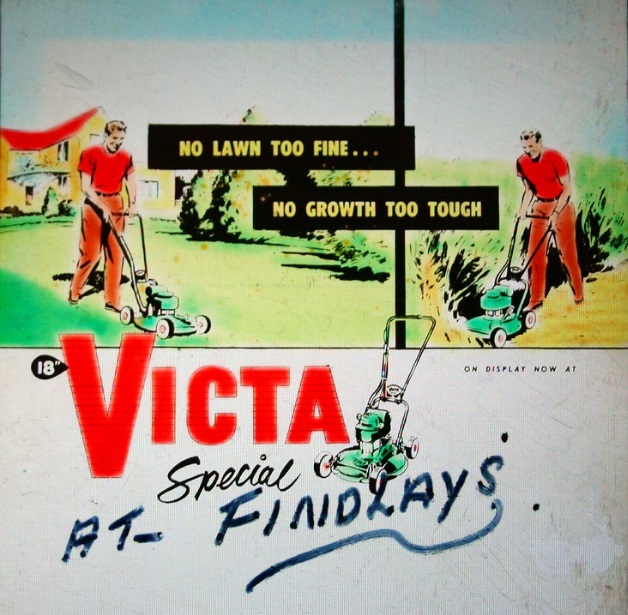
Victa motor mowers - glass cinema slide circa 1950s
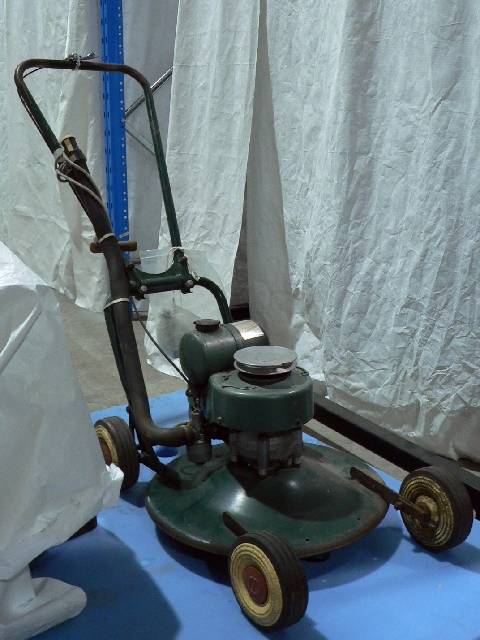
1959 Victa Special 18 inch Model 5 Lawnmower - The 1959 Victa Special 18 inch Model 5 Lawnmover in the J Bickle collection has a circular central body with underneath blade, and four red, yellow and black rubber tyres. The handle for the lawn mower is adjustable and features a pull cord on one side and a silver switch at the top. The former owner, Mr Bickle, purchased the lawnmower at J.B. Young, Manuka, in 1958. J.B. Young, at that time, operated as a co-operative where shoppers owned shares and gave their membership number when making purchases. Copyright National Museum of Australia / CC BY-SA 4.0.
Victa 'New Utility' Series 70 2-stroke lawnmower, c.1968. Copyright National Museum of Australia / CC BY-SA 4.0.
During the early 1960s Garry Richardson played an increasingly important role in the company and succeeded Mervyn as chairman in 1965. The company was sold to the Sunbeam Corporation Ltd in 1970. In later years, the company was owned by GUD Holdings Limited, who sold the Victa Lawn Care business to American-based Briggs & Stratton for A$23 million in 2008.
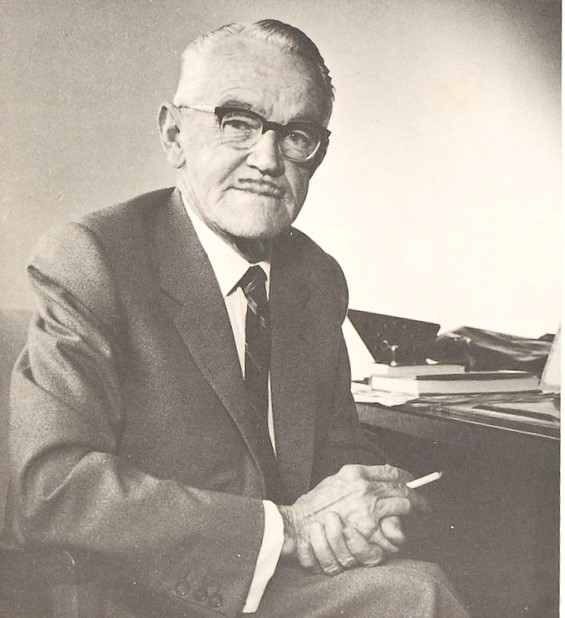
Mervyn Victor Richardson, circa 1961 - from Victa Co. materials
Survived by his wife and their son, Mervyn Richardson died on 31 December 1972 at St Luke's Hospital, Darlinghurst, and was cremated with Anglican rites.
In 1994 the factory moved to Campsie, where the seven millionth Victa lawnmower was built in 1997. The Richardson radial aero-engine and the Victa prototype lawnmower (1952) are held by the Powerhouse Museum, Sydney.
The Victa Lawnmower is to many an Australian icon whose status was confirmed by its inclusion in the opening ceremony of the Sydney 2000 Olympic Games.
Although you may not see too many of that original 'peach tin' 1952 models in working order, having an early or original Victa lawnmower on display at your local lawnmower dealer remains an all-Australian symbol, while older models, parts, the logo, or even posters and company materials, are collected by all those who want something celebrating Australian ingenuity and hard work in their garage, backyard men's shed.
References And Extras
- TROVE - National Library of Australia
- Richard V. Wood, 'Richardson, Mervyn Victor (1893–1972)', Australian Dictionary of Biography, National Centre of Biography, Australian National University, http://adb.anu.edu.au/biography/richardson-mervyn-victor-11517/text20505, published first in hardcopy 2002
- Victa mowers : Victa, Mayfair, Pace, Sunbeam and other mowers made by Victa at the time of publication : official Victa workshop manual / prepared by Gregory's Publishing Company [ Book : 1981-1984 ]
- SPEECH BY THE PRIME MINISTER, MR RJL HAWKE, AT LAUNCHING OF NEW VICTA MOWER, SYDNEY, 12 AUGUST 1983. Hawke, Robert [ Article : 1983 ] Available online.
Job no. 2736: Richardson of Victa lawnmowers, house Kumale, 949 Barrenjoey Road, Palm Beach, built 1955-56, design by: Peter Muller, photographs at night, November 1958 / photographs by Max Dupain.
Listing/protection: Pittwater Local Environmental Plan RAIA NSW Chapter – Register of 20th Century Buildings of Significance
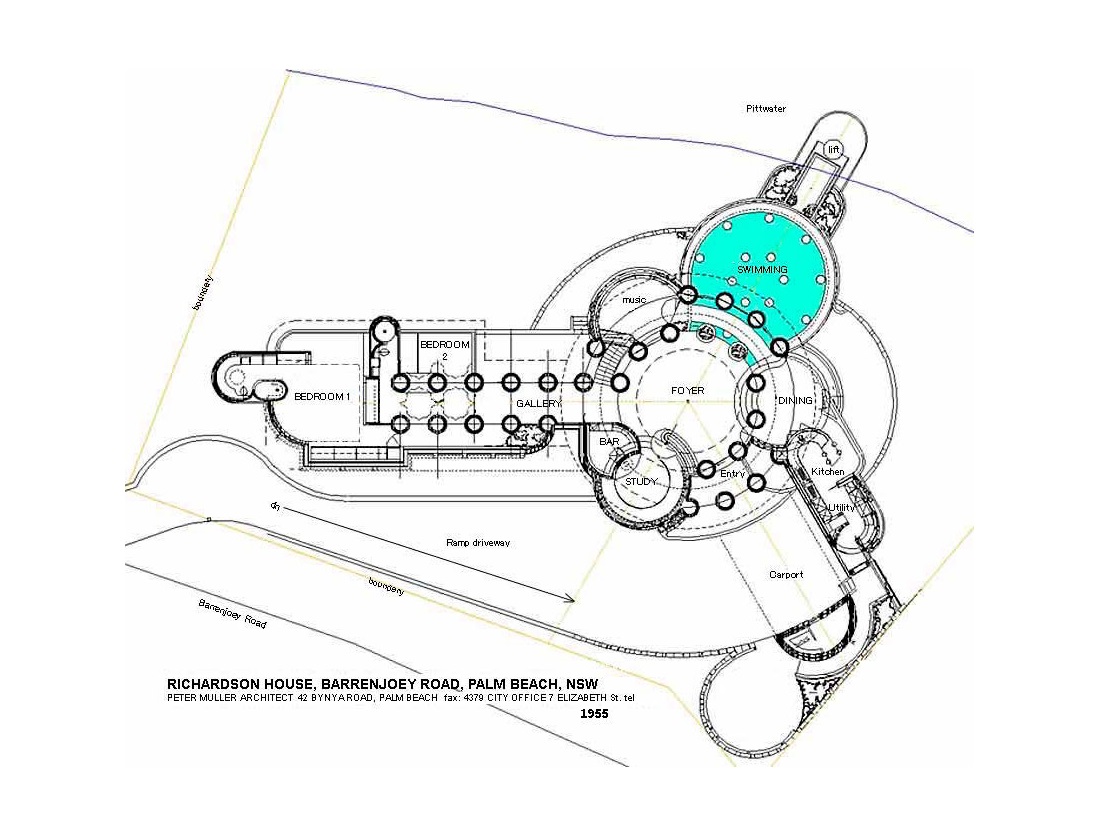
Kumale - original plan, 1955 - © Peter Muller
Job no. 3241: Victa Motor Mowers, factory interiors, possibly at Moorebank, July 1959 / photographs by Max Dupain
Job no. 3361A: Portrait of Richardson for Victa Lawnmowers, October 1959 / photographs by Max Dupain
Victa Consolidated Industries - Peter Muller designed H.O. for VCI
The Richardson Monoplane
The twin row rotary aero engine was designed by Archibald (Archie) Richardson (b. 1886?) probably in 1912. The engine was not a copy of existing technology although it used parts already available to cut costs.
In 1913, Richardson, together with his brother Mervyn and friends Harold Eagle, Leslie Hankie (b. ca 1894) and Ted Sparks, built an aeroplane and engine incorporating Archie's engine design.
Work on the engine commenced in 1913 in the engineering workshop at Rupert Cook's Brickworks in Enfield. Cook, Eagle's grandfather, financed his grandson’s Australian designed and built aero engine and airframe. The engine was made entirely by Eagle, including castings and forgings.
Leslie Hankie, a carpenter, built the airframe at his father’s joinery works in Concord.
Reference: Library correspondence file SCOPE AND CONTENTPXB 449 (photographic prints) - held by State Library of NSW
1. Harold Eagle in the cockpit of the aeroplane in the backyard of the house in Burwood Road, Enfield (which adjoined the brickyard where the aeroplane had its preliminary tests), early 1916
2. At Richmond, late 1916; left to right: Harold “Curly” Eagle with hand on wheel, Archie Richardson, person unknown to Norman Eagle [but probably Ted Sparks or the test pilot], and Leslie Hankie with the aeroplane
3-4. Aeroplane, Richmond, 1916
5. Hangar, Dept of Education Flying School, Richmond with aeroplane at hangar door
6. Aeroplane with a De Havilland model inside the Dept of Education Flying School hangar, Richmond, late 1916 (neg. at ON 304/1)
7. "Flying into history – 58 years late”, Aeroplane Press, vol. 32, no. 24, Wed 12 June 1974
ON 429 (negatives)
1. Aeroplane with a De Havilland model inside the Dept of Education Flying School hangar, Richmond, late 1916 (print at PXB 449)
2. Aeroplane on the airfield, Dept of Education Flying School, Richmond, late 1916
3. Front view of engine
4. Rear view of engine (half of negative missing)
SOURCE Presented by Mr Norman Eagle, 1977 Pic.Acc.3889
Access to this pictures collection via appointment only.
Please acknowledge: : Mitchell Library, State Library of New South Wales
Information published in: “Flying into history – 58 years late”, Aeroplane Press, vol. 32, no. 24, Wed 12 June 1974
Richardson's twin row rotary aero engine is radial and balanced utilising Newton’s third law of motion - every action has an equal and opposite reaction. It has two contra-rotating timber propellers. The outer section, crankcase and cylinders are mounted in a cradle, free to revolve, to which a propeller is attached. This propeller is left hand pitch, rotating anti-clockwise. The crankshaft, pistons and rods are of equal weight to crankcase and cylinders.
The second propeller is attached to the crankshaft and is right hand pitch, rotating clockwise. There is no gearing between rotating units of the engine, being equal in weight and equal pitch of propeller, both halves rotate in opposite directions at the same speed.
The engine was started by holding the outer propeller stationary and swinging the inner clockwise to energise the magnets. When the engine was running, the outer propeller was released and the opposite reaction began. The engine weighs 125 lbs and developed 100 h.p. Fuel injection allowed the engine to run in any position during flight.
The airframe had a 22 ft wingspan and 18 ft fuselage. It was high wing monoplane using 6 ft propellers.
Once assembled the aeroplane was tested by tying it to a tree and “flying” in circles. The engine was run at maximum revolutions for 36 hours, dismantled, checked and reassembled.
After completion in 1916, the aeroplane was towed to the runaway at Richmond for further testing by an experienced pilot who found the tail heavy and suggested alterations. When the pilot failed to return after six weeks, the designers decided to do their own ground tests. The aeroplane was to run at ground speed while a rider on a Henderson motorcycle with speedometer recorded the speed by riding alongside. The aeroplane quickly attained airspeed and left the motorcycle behind. The man at the controls, not being a pilot, landed heavily overturning the aeroplane.
Damaged beyond repair, it was towed back to Enfield where the airframe was hung by wires from the roof until 1935. Falling apart, it was then taken down and burnt. The engine was stored under Harold Eagle’s house in Strathfield until his son Norman Eagle rediscovered it circa. 1972. He began to restore the engine hoping to rebuild the aeroplane.
In 1993, Norman Eagle presented the engine, and a film of the 1916 testing, to the Powerhouse Museum. (Powerhouse registration number 93/399/1)
References: Library Correspondence file and “Flying into history – 58 years late”, in Aeroplane Press, vol. 32, no. 24, 12 June 1974 DATE NOTE: Dated by the donor
BUILDING A PLANE THE VICTA WAY
When World War 11 burst suddenly over Europe in 1939, the armed forces of many Commonwealth countries had to be built up practically overnight, and almost from a zero start Australia, the youngest of the Commonwealth countries, remote in its isolation, was to be no exception, and the strain on the continent's training resources almost reached breaking point.
The Air Force was perhaps the most seriously affected of all the armed services for it had to find thousands of safe light trainer aircraft to train the fledgling fliers who were soon, to bum their names in immortal glory across the skies of many countries. The tiny Tiger Moth, built almost entirely of fabric, plywood and wire, provided the immediate answer. But it had finite limitations, and already engineers and striving towards the ultimate in light aircraft . . . the safe, sturdy, economical all metal plane!
It was to be no easy task ... no project that would be resolved during the course of the War or even for many years after, but it was a designer's dream that was one day to become a reality with the birth of the Victa Airtourer.
FAMILIAR SIGHT
Today the Victa is a familiar sight in our skies and the name a catchword for excitement among the new generation of Australian pilots. The Victa was to prove a versatile little aircraft with an incredibly low drag . . . lower than either the Spitfire or the Mustang with their undercarriage retracted, and with the amazing manoevrability of a fighter plane.
It has taken more than 12 years of design, redesign and experiment, and ^thousands of hours of hard work to reach today's standard of achievement.
LOVE OF FLYING
The Victa was conceived out of pure love of flying by its designer and nursed through its teething troubles by a group of .dedicated people, and finally helped to maturity by the concentrated financial and production efforts of the Victa company. The idea of the Victa Airtourer 100 design, stems originally from winning design produced in 1952-53 by a team of three Australians for a light aircraft competition sponsored by the Royal Aero Club of Great Britain.
The team consisted of Henry K. Millicer, a naturalised Polish Air Force pilot as designer, G. B. Bennett, an experienced stress diesigner and J. Tatty as detail draftsman. All were then employees of Government Aircraft Factories. Their entry, 'No 97' as it was then called, won the first prize from 103 other contestants.
For three years after winning the competition the design lay dormant but not completely abandoned. Eventually in October 1955, an organisation known as the Ultra Light Aircraft Association of Australia, was formed in Melbourne. Several Australian companies helped the project with donations of their products, some of them of the automotive type. Eventually the whole project had to be redesigned to incorporate changes made necessary by the equipment donated. The construction of the modified aircraft so impressed the executives of the Aero Club Federation of Australia that it decided to help financially towards its completion as a standard Australian club trainer. Accordingly, a £100 subsidy was voted by the Federation Conference in April, 1958.
With that money several contracts were let' by the Airtourer Group to complete the prototype. Eventually, after a lot of I work, the aircraft was assembled and its Certificate of Airworthiness issued on July 31st, 1959. This was the first of such certificates to be issued for a light Australian designed aircraft since 1939. After certification, the Airtourer' prototype was flown to Tamworth for evaluation by East West Airlines, whose interest persuaded them to help complete it.
PRODUCTION PRODUCTION STARTS
In August 1960, Messrs Richardsons of Victa Consolidated Industries decided to produce the Airtourers in Sydney. The original designer, Henry Millicer, resigned his appointment with G.A.F. and joined Victa as Chief Aircraft Designer, together with some of his team.
In December, 1960 the aircraft was re-engined with a Continental 0-200 engine and designed as an all metal fully acrobatic aircraft. The new design was based on the aerodynamic shape of the wooden Airtourer but became a completely new design called Airtourer 100. It flew for the first time on 12th December, 1961 and after a very extensive flight evaluation, received its full Type Approval on July 4th, 1962. This was the first such document ever issued to an Australian, designed and built aircraft.
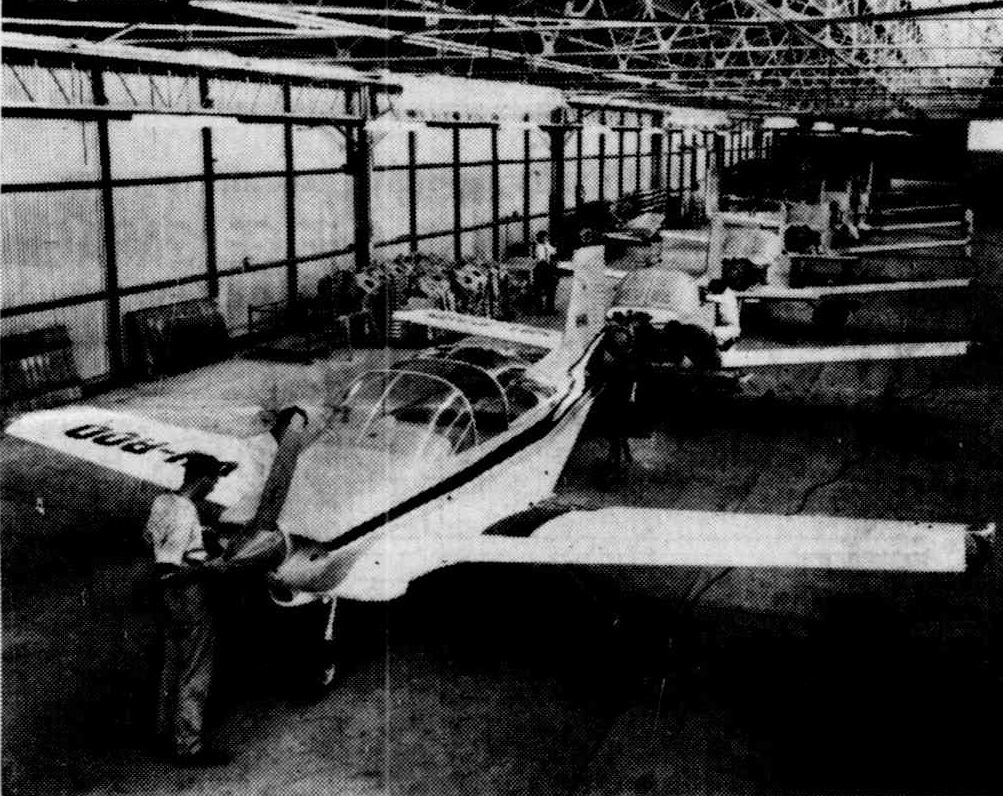
NOW 88 AIRCRAFT
Now almost 88 aircraft; of the Airtourer type have flown out of the Victa plant at Milperra and enquiries are coming, not only from all parts of Australia, but from many countries abroad.
Today, the average Australian, particularly the young Australian, is becoming more and more air- minded and having a plane or learning to fly appears to he just as natural and just as necessary as owning or driving a car. The Victa is the fastest little single engine, fixed undercarriage aircraft under 160 h.p. in Australia. The low 'drag' for which it has become famous has been achieved by 'very careful aerodynamic design and a very careful detail of ail outside surfaces. For example, the control surfaces of the elevator, rudder, ailerons and flaps have 'flutes' pressed on them to reduce weight. The direction of these 'flutes' is unique, in that it follows faithfully the streamlines on every surface.
Another example is the streamlining of the main undercarriage legs and. their attachment to the wings. Tills adds another 5 m.p.h. to the aircraft.
The Victa has been stressed to 9 g. design ultimate load factor (equivalent to 9 times the force of gravity) . permitting M^i turbulence penetration speeds, and also permitting full acrobatics. With an all-up weight of 1650 lbs., the Airtourer 100 has a maximum speed of 138 m.p.h., a maximum cruising speed of 128 m.p.h. and an economy cruising speed of 109 m.p.h. Its best average rate of climb is 675 feet per minute and its stalling speed is 53 m.pli. Because of its easy handling, due to its extremely high manoeuvrability the aircraft is very docile. It is rather an unusual fact that the petrol economy is far better than that of any car. The Victa's fuel consumption at an average of 4 galls, per hour produces a cruising speed of 120 m.pli. No car in world can cruise at 120 m.p.h. on a fuel consumption of 30 miles per gallon!
Among the purely original sections of the Victa are: —
- the type of flap and aileron control - providing manoevrability
- the idea of using flaps as ailerons to provide an extremely high rate of roll
- the large use of easily obtainable automotive parts:
The nose undercarriage, for instance, consists of an orthodox motor car shock strut and spring, while the ; main undercarriage is made from spring steel used for motor trucks, making it simple, strong and cheap.
The whole theme of the Airtourer design is centred : | round strength, economy and safety. Hie wing of the Victa is so strong it is capable of supporting 4 fully laden motor 'vehicles. This strength factor is on a par with that of modern fighter aircraft.. Universally accepted by Australian and New Zealand Aero Clubs, the Victa Airtourer has already flown . millions of miles both in Australia -and Overseas. Recently it received a unique compliment and endorsement par excellence, when one was purchased by the Department of Civil Aviation for use by its North Queensland surveyors.
The production rate of Victa aircraft has been rapidly stepped up. The Deputy Chairman of Victa Ltd., Mr. G. B. Richardson, said an increase in production to 9 aircraft a month was part of his company's policy to gain the maximum utilisation of the aviation plant.
In the little over two years since the Airtourer was granted a Certificate of Type approval by the Department of Civil Aviation, the little aircraft has achieved tremendous success.
Victa executives Claim the Airtourers have almost completely dominated the two seater market with sales totalling of more than 82% of all the two-seater aircraft sold in Australia.
NO DEPOSIT PLAN
One of the reasons for the aircraft's popularity, completely apart from its price, economy and high performance has been its easy system, of purchase. The response to the Company's advertised No Deposit Flyaway plan has been staggering. The Victa Flyaway plan allows for an approved purchaser to their delivery of one of the company's aircraft (either the Rolls Royce powered 100 or the Lycoming powered 115) on no deposit, with repayments spread over 4 years.
This is the first time such a deal has been offered light aircraft enthusiasts in Australia. Another/incentive towards successful marketing is the provision of free flying lessons, either by Arrangement with local aero clubs or by an instructor approved by the Department of Civil Aviation.
Other financial arrangements include the special Co-operative Group Finance plan. This Group method of financing an aircraft expected to revolutionise the light aircraft industry. It allows for the cost of the aircraft to be shared by, gay 10 members who: form themselves into a Cooperative group. The new finance technique developed by Victa allows for enthusiasts on a lower wage level to jointly own and learn to fly the group's own aircraft. Victa is determined to make owning and flying an aircraft as simple as owning and driving a motor car. BUILDING A PLANE THE VICTA WAY (1964, October 9). Western Herald (Bourke, NSW : 1887 - 1970), p. 5. Retrieved from http://nla.gov.au/nla.news-article141982189
Powerhouse Museum Richardson Records:
The archive has a genealogical significance in that the documents were originally collected by Violet May Richardson (Mervyn’s eldest sister), whose son, Neville, maintained and extended the archive and bequethed them to his daughters, who are the donors of the material to the Museum. The archive consists of the following documents:
(1) The October 1927 edition of the journal 'The Australian Motor Owner' (p.44), showing a black and white photograph of M.V. Richardson. There is only one page of the journal available.
(2) A 12 page brochure published and issued by L.J. Hooker (Australia's leader in Real Estate) for the auction on Tuesday, 13 September, 1966 of 'Kumale', the family home of M.V. Richardson. The brochure also contains details of the auction, on the same day, of 'Wharfdale' the house next door.
(3) An undated single typed page by Archibald Newton Wesley Richardson (1892-1942), Mervyn's brother, setting out his (Archibald's) ideas on the development of an aeroplane.
(4) An undated booklet describing the Victa Aviation story, with an introduction by D.G. Anderson, Director General, Department of Civil Aviation.
(5) Newspaper article entitled 'Men of Genius', Sunday Mirror, September 17, 1961, p. 51., on M.V. Richardson.
(6) Newspaper supplement, The Sydney Morning Herald Annual Review of Aviation and Astronautics, 1964. Photograph of M.V. Richardson and D.G. Anderson (Director-General of Civil Aviation), who accepts the delivery of a Victa Airtourer from Richardson.
(7) Newspaper article entitled 'The House a Lottery Couldn't Buy' (The Sun, Tuesday, August 2, 1966, p.2). Article with pictures of 'Kumale'.
(8) Newspaper clipping (details unknown) entitled 'Tour By Director' stating that M.V. Richardson was to tour the U.S.A and South America to explore the potential market for his lawn mowers.
(9) Newspaper clipping (details unknown), entitled 'Company's Great Hopes', on the Victa home-building division.
(10) Newspaper clipping (details unknown), showing a picture of M.V. Richardson and his wife Vera (nee Bertram), on the wharf prior to sailing to the USA and South America.
(11) Newspaper clipping (details unknown, but on 13 September, 1966) on the auction of 'Kumale', entitled '$110,000 offer on Dream Home'. The house was passed in at auction, not having reached the reserve of $140,000.
(12) Newspaper clipping (Daily Telegraph, August 4, 1965, p.22), entitled '12 Years' Hard Work, now He will Rest', on the 'retirement' of M.V. Richardson. A second copy is also included in the archive.
(13) Newspaper clipping (The Sun, date and page unknown), entitled 'A Man's Success Story', on M.V. Richardson's proposal to establish Victa Development Corporation Ltd., for large-scale home building.
(14) Newspaper clipping (details unknown), entitled 'There's Money in not Letting Grass Grow', on M.V. Richardson and his firm.
(15) Newspaper clipping (The Sun Herald, August 22, 1965, p.17) entitled 'At 60 you can be a millionaire'. General article on the life and work of M. V. Richardson.
(16) Newspaper clipping (Daily Mirror, Thursday, October 20, 1960, p.46), entitled 'Women at the Top: Backstop to a Millionaire' on the domestic role played by Mrs Mervyn Richardson (Vera Bertram).
(17) Newspaper clippings (details unknown), entitled 'From Concord Cottage to This: Millionaire Wife Keeps Friends' and 'Cut Lunch for Millionaire', on the domestic role played by Mrs Richardson.
(18) Newspaper clipping (The Sun-Herald, March 25, 1962, p.7), entitled 'Sydney Co., in new Field', on the Victa AirTourer 100 aircraft.
(19) Newspaper clipping (details unknown, but dated 8/10/64), entitled 'The Man Who Began it All', on the development of the Victa lawn mower.
(20) Newsletter, Royal Aero Club of New South Wales (Vol. 2, No. 8, December, 1961), with photographs of Gary Richardson.
(21) Publication, 'Victa Aviation Division News Bulletin' (no date), on the history of, and with technical specifications for, the Victa Airtourer 100.
(22) A page from 'Air Progress' (January, 1967, p. 32), entitled 'Australia's "Aircruiser" Enters Four-Seater Field', with photographs and a brief technical description of the Victa Airtourer.
(23) Journal article, Pix (June 10, 1961), three-page article with photographs on M.V. Richardson, his businesses, and 'Kumale'.
(24) Journal article, Pix (April, 22, 1962, pp.22-24), on the Richardson's (Archibald and Mervyn's) 1914 monoplane, the Victa Airtourer 100, and the 6 cylinder, 2 cycle rotary engine (1914).
(25) Journal article, Pix (August 27, 1966, pp.12-15), on the interior and exterior of 'Kumale'.
(26) Journal article, Woman's Day (March 30, 1964, pp.54-55), article and photographs of the Richardson's at 'Kumale'.
(27) Journal article, Woman's Day, (August 29, 1966, pp.2-3), article about 'Kumale'.
(28) Genealogy of Mervyn Victor Richardson, showing his parents, his brother and three sisters, their marriages and children, and the children's marriages down to the donors of the archive (Elizabeth and Joanne Williams).
(29) Great grandfather's Richardson's bible (Mervyn Richardson's father). The bible was given to Mervyn's father, by his mother, as stated on the frontispiece. One of the donor's (Elizabeth Williams) advised that the bible was found in her parent's possessions in February 2007. Her father's mother was Violet Richardson, Mervyn's eldest sister (see the back pages of the bible for details of their family).
(30) Mervyn's son, Gary (1931-2005), who helped his father considerably in the development of Victa Mowers Pty Ltd., graduated from Sydney University in 1956 with first-class honours in psychology. He wrote three books included in this archive: Education for Freedom: Blueprint for a Human-Centred School (1985); Philosophy of Conscoius Action (1987), this work includes an 8 page fax (24 January, 1995) from Gary to one of the donors (Elizabeth Williams), which sets out an early draft of the book's Introduction and text for what was going to be Chapter 19 (The Way of Development), neither of which appeared in the published version, and Love as Conscious Action:Self Development for the New Society (1992). It was the philosophy of the first book that he used to establish (1978), with a group of parents, Korowal School at Leura in the Blue Mountains.
Short URL https://ma.as/372128
